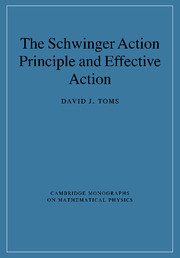Book contents
- Frontmatter
- Contents
- Preface
- 1 Action principle in classical mechanics
- 2 Action principle in classical field theory
- 3 Action principle in quantum theory
- 4 The effective action
- 5 Quantum statistical mechanics
- 6 Effective action at finite temperature
- 7 Further applications of the Schwinger action principle
- 8 General definition of the effective action
- Appendix 1 Mathematical appendices
- Appendix 2 Review of special relativity
- Appendix 3 Interaction picture
- Bibliography
- Index
4 - The effective action
Published online by Cambridge University Press: 27 October 2009
- Frontmatter
- Contents
- Preface
- 1 Action principle in classical mechanics
- 2 Action principle in classical field theory
- 3 Action principle in quantum theory
- 4 The effective action
- 5 Quantum statistical mechanics
- 6 Effective action at finite temperature
- 7 Further applications of the Schwinger action principle
- 8 General definition of the effective action
- Appendix 1 Mathematical appendices
- Appendix 2 Review of special relativity
- Appendix 3 Interaction picture
- Bibliography
- Index
Summary
Introduction
The development of relativistic quantum field theory was stimulated by the need to deal with scattering processes in high energy physics. A successful implementation of quantum electrodynamics was given in the late 1940s and early 1950s. The applications of this theory are described in the classic textbooks and a history of the subject is given in Schweber (1994). Similar methods may be applied to the more modern standard model which deals with the weak and electromagnetic interactions of quarks and leptons. It is perfectly possible to extend the start we have made in Chapter 3 to make contact with this approach which concentrates on the calculation of scattering amplitudes and cross-sections. Instead of pursuing this more traditional path we will adopt an alternate approach which is useful for understanding symmetry breaking and phase transitions in physics. The principal aim of this chapter will be to develop the effective action method in a very simple way and apply it to a number of problems. It is not necessary to use the full formalism of the effective action to follow simple applications, and we will postpone the full development until Chapter 8.
In the last chapter we saw how quantum field theory was obtained from classical field theory by replacing the classical field variables with appropriate operators. In this chapter we wish to go back to dealing with ordinary field variables again, but with ones that somehow include quantum corrections to the classical theory.
- Type
- Chapter
- Information
- The Schwinger Action Principle and Effective Action , pp. 169 - 207Publisher: Cambridge University PressPrint publication year: 2007



